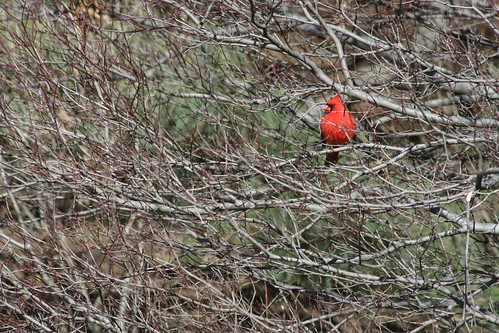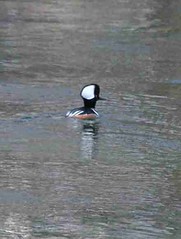Plan Your Weekend: The Garden’s Annual Bird Count
Posted in Learning Experiences, Programs and Events, Wildlife on December 12 2008, by Plant Talk
Here’s What You May See on the Tally
 |
Debbie Becker leads a free bird walk at the Garden every Saturday from 11 a.m. to 12:30 p.m., beginning at the Reflecting Pool in the Leon Levy Visitor Center. Join her tomorrow, December 13, for the 2008 New York Botanical Garden Bird Count. |
 Every year at this time, birders flock to the parks and woods across the country and beyond for National Audubon Society’s annual Christmas Bird Count. From dawn’s early light until dusk birders count all the birds they can find using a specific method and within precise geographic areas. At the end of the day the counts are tallied and compared to numbers from previous years. The information is used to determine if a bird species is in trouble or declining. Past revelations included lower than usual numbers of house finches, most likely due to conjunctivitis, and decimated crow numbers, presumably due to West Nile Virus. Occasionally, a rarity will pop up on the count as birders scour the shorelines, forests, and meadows looking for elusive visitors to their areas. Past special sightings at the Botanical Garden, which is part of Audubon’s 84-year-old Bronx-Westchester count, include common redpolls, chipping sparrows, pine warblers, Baltimore orioles, and a merlin.
Every year at this time, birders flock to the parks and woods across the country and beyond for National Audubon Society’s annual Christmas Bird Count. From dawn’s early light until dusk birders count all the birds they can find using a specific method and within precise geographic areas. At the end of the day the counts are tallied and compared to numbers from previous years. The information is used to determine if a bird species is in trouble or declining. Past revelations included lower than usual numbers of house finches, most likely due to conjunctivitis, and decimated crow numbers, presumably due to West Nile Virus. Occasionally, a rarity will pop up on the count as birders scour the shorelines, forests, and meadows looking for elusive visitors to their areas. Past special sightings at the Botanical Garden, which is part of Audubon’s 84-year-old Bronx-Westchester count, include common redpolls, chipping sparrows, pine warblers, Baltimore orioles, and a merlin.
Twenty years ago I started the Garden’s own unofficial bird count, a low-keyed version that is fun and educational. Instead of gathering at 5 a.m., we meet at 11 a.m. and set out to count the birds at NYBG. I keep a list of the most common New York City birds and put strokes near their names as we spot them flying by. The two decades of data from our informal count confirms the trends found in the Audubon count.
Read about the birds likely to be found on the count and of a special sighting last year after the jump.
UPDATE 12/18/08: Bird walk results
Count day was sunny and cold, with temperatures in the 20s. Nineteen people participated; the count lasted three hours and turned up 24 species and 105 birds overall. Highlights of the day included a northern shoveler at Twin Lakes, both the female and male great horned owls in the Forest, and a goshawk, for the second year in a row, by the Prop Range. A flock of house finches, a brown creeper, and a house wren also were good finds. The full list is noted here.
House finch: 12; House sparrow: 3; White-throated sparrow: 5; Black-capped chickadee: 8; Dark-eyed junco: 15; House wren: 1; American crow: 1; Blue jay: 2; Northern cardinal: 2; Mourning dove: 9; American robin: 3; Red-bellied woodpecker: 1; Downy woodpecker: 1; Tufted titmouse: 3; White-breasted nuthatch: 1; Brown creeper: 1; Northern mockingbird: 3; Hermit thrush: 2; Great horned owl: 2; Red-tailed hawk: 2; Northern goshawk: 1; Northern shoveler: 1; Mallard: 23; Hooded merganser: 3; (Last week, 30 wood ducks were counted.)
 We usually start our count at Twin Lakes looking for winter ducks. Occasionally, we are treated to a new visitor. Last year a pied-billed grebe and a ring-necked duck made our list. Wood ducks are always a treat to see on the Lakes. Their multi-colored feathers make them look more like painted decoys instead of real ducks. The wood duck population is booming at NYBG. Based on last May’s brood, I can easily project that this year’s count of wood ducks will far outnumber previous years. NYBG may have the largest population of breeding wood ducks in New York City.
We usually start our count at Twin Lakes looking for winter ducks. Occasionally, we are treated to a new visitor. Last year a pied-billed grebe and a ring-necked duck made our list. Wood ducks are always a treat to see on the Lakes. Their multi-colored feathers make them look more like painted decoys instead of real ducks. The wood duck population is booming at NYBG. Based on last May’s brood, I can easily project that this year’s count of wood ducks will far outnumber previous years. NYBG may have the largest population of breeding wood ducks in New York City.
After visiting the Lakes we head for the trail that takes us into the Forest looking for our mysterious great horned owls. Our resident owls will begin their mating rituals toward the end of December, but rest assured they will be visible before then within the bare trees, and the male will be exercising his territorial rights by hooting loudly at dusk. Adding the great horned owls to the bird count is exciting, because the male has lived at the Garden for almost 20 years. He is a regular on our bird count list.
The Forest trail leads us down to Azalea Way, where we will pick up dark-eyed juncos, red-bellied wood peckers, white-throated sparrows, northern cardinals, black-capped chickadees, tufted titmice, American goldfinches, and both red-breasted and white-breasted nuthatches. On to the Bronx River we go, where we will hopefully find our hooded mergansers. The mergansers are winter visitors to the Garden and are always a delight to see and add to our list. They are brightly feathered and dive under the water looking for morsels to eat. The male and female are almost always accompanied by an offspring.
Last year we glimpsed by the river a large hawk-like bird that was slightly bigger than a Cooper’s hawk but smaller than a red-tailed hawk. We followed the mystery raptor, sometimes running to catch up with it. None of us could get a good look, though suspicions ran high. Finally, the bird of prey landed in a conifer along the Benenson path. We ambled up to each tree and peered in, hoping to catch a glimpse of this elusive hawk. As I knelt under a spruce to take a look, the bird flushed, almost knocking me to the ground. As it flew, all the birders pointed in the same direction. “Goshawk,” we all yelled. The goshawk is a spectacular bird that rarely visits the Garden. It gave us a quick look as we watched it fly back into the woods. Breathless from the chase, we were all happy with the day’s bird count and the look at our fleeting raptor.
Later that day as I sat on a hill near the Conservatory with Melanie, a fellow birder, watching American robins eating the last edibles from a cherry tree, we talked about how wonderful the day had been and all the great birds we had viewed. Too bad, we both thought, that we hadn’t found the goshawk sooner and gotten a really good look at its magnificently striped belly. At that very moment we heard a whooshing sound, and in front of our very eyes the goshawk flew up above the hill on a thermal of warm air, in hot pursuit of a cherry-eating robin. We could see the goshawk’s eyes, stripes, beak, everything! What a wonderful look at a magnificent bird and what a wonderful way to end the annual New York Botanical Garden Unofficial Bird Count.
Check out all of Saturday’s programming.
Check out all of Sunday’s programming.


very interesting. I’ll let some of the 50 plusers know about this